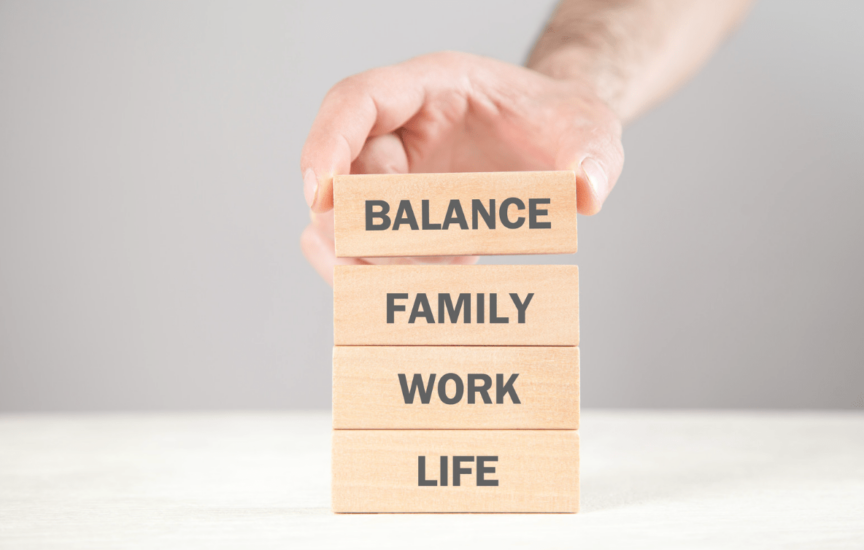Creating and maintaining healthy boundaries between your work and personal life is an ongoing journey that can significantly impact your well-being and overall satisfaction. In an age where remote work and digital connectivity blur the lines between professional and personal domains, it’s more important than ever to establish clear boundaries that allow you to thrive in both areas. This article delves deeper into each aspect of creating and managing these boundaries, offering a comprehensive guide to help you navigate the delicate balance between work and personal life.
Designate a Workspace:
One of the fundamental steps in separating work and personal life is to designate a specific workspace. This is especially relevant if you’ve transitioned to remote work or have the flexibility to work from home. Having a dedicated workspace helps create a mental and physical boundary between your professional and personal life.
When choosing a workspace, consider factors like comfort, productivity, and minimizing distractions. Ideally, it should be a room or area separate from your living space. This separation sends a clear signal that when you’re in your workspace, you’re in work mode, and when you leave it, you’re stepping back into your personal life.
The importance of a designated workspace cannot be overstated. It not only helps you focus on your tasks but also enables you to disconnect mentally when you leave that space, promoting a healthier work-life balance.
Set Clear Work Hours:
Establishing clear work hours is essential for maintaining boundaries between your professional and personal life. When you work remotely or have a flexible schedule, it’s easy for work to spill over into your personal time. To prevent this, define your work hours and communicate them to your colleagues, friends, and family.
Clearly stating your work hours helps set expectations for when you’ll be available for work-related tasks and when you won’t. It also encourages others to respect your time and personal life. When you’re off the clock, you should be able to focus on your personal priorities without the constant pull of work-related responsibilities.
Prioritize Self-Care:
Self-care is a crucial aspect of maintaining a healthy work-life balance. It involves taking deliberate actions to care for your physical, mental, and emotional well-being. Neglecting self-care can lead to burnout and a diminished quality of life.
Make self-care a non-negotiable part of your routine. This can include regular exercise, pursuing hobbies and interests, practicing mindfulness or meditation, and simply taking time to relax. By dedicating time to self-care activities, you signal to yourself and others that your personal life is just as important as your work.
Self-care isn’t selfish; it’s a necessary investment in your overall happiness and productivity. When you take care of yourself, you’re better equipped to handle the demands of your job and personal responsibilities.
Limit Digital Accessibility:
In today’s hyper-connected world, it’s easy to be constantly tethered to work through digital devices. To establish clear boundaries, consider limiting your digital accessibility during non-work hours. This includes turning off work-related notifications, emails, and messages.
Utilize “do not disturb” settings on your devices to minimize distractions. Communicate your digital boundaries to your colleagues, making it clear that you won’t be available for non-urgent work-related matters outside of your established work hours.
By disconnecting digitally from work, you create space for personal activities and reduce the mental clutter that often accompanies a constant barrage of work-related notifications.
Establish Boundaries with Family and Friends:
Effective boundary setting isn’t limited to your professional life; it extends to your personal relationships as well. Communicate with your loved ones about your work boundaries, so they understand when you need uninterrupted work time and when you’re available for socializing or spending time together.
It can be challenging to balance work and family life, especially when working from home. Clearly defining your work hours and communicating them with your family can help avoid conflicts and misunderstandings. When you’re present with your loved ones, strive to be fully engaged and attentive, reinforcing the importance of quality personal time.
Create a Daily Routine:
A well-structured daily routine can be a powerful tool for maintaining a work-life balance. It helps you allocate time for both work and personal activities, ensuring that neither aspect dominates your life.
Start by scheduling your work hours and personal commitments. Then, build in time for self-care, meals, exercise, and relaxation. Having a routine provides a sense of stability and predictability, reducing stress and enabling you to better manage your time.
Adhering to a daily routine also helps you transition between work and personal life more smoothly. It signals when it’s time to shift your focus from professional responsibilities to personal enjoyment and vice versa.
Learn to Say No:
One of the challenges of establishing boundaries is learning to say no when necessary. Overcommitting to work-related tasks or personal obligations can lead to stress and burnout. Setting realistic limits and declining additional responsibilities when you’re already stretched thin is crucial for maintaining balance.
Practice assertiveness in a respectful and considerate manner. Explain your current commitments and why you can’t take on more without feeling guilty. People who respect your boundaries will appreciate your honesty, and you’ll avoid spreading yourself too thin.
Plan Regular Breaks:
Taking breaks throughout your workday is vital for maintaining productivity and well-being. Use these breaks as opportunities to recharge and refocus. Step away from your workspace, stretch, or engage in a brief relaxation exercise.
Scheduled breaks help prevent burnout and improve overall job satisfaction. They also create natural transitions between work and personal tasks, allowing you to reset and approach each with renewed energy and enthusiasm.
Set Technology Boundaries:
Digital devices are powerful tools, but they can also be sources of constant distraction and intrusion into your personal life. To mitigate this, consider implementing technology boundaries, such as designated “no-screen” times.
For example, establish rules like no phones or laptops during meals or before bedtime. These boundaries encourage mindfulness and promote face-to-face interactions with family and friends. They also allow you to disconnect from work-related communications and be fully present in your personal life.
Regularly Reflect and Adjust:
Boundaries are not set in stone; they should be flexible and adaptable to your changing circumstances and priorities. Periodically evaluate how well your boundaries are working for you and be willing to make adjustments as needed.
As your job responsibilities, personal commitments, and life circumstances evolve, your boundaries may need to evolve with them. Regular reflection and adjustment ensure that your boundaries remain effective in supporting your well-being and work-life balance.
Incorporating these strategies into your life can help you establish and maintain healthier boundaries between work and personal life. However, navigating these boundaries can be a complex and sometimes challenging process, and it’s okay to seek support and guidance.
The Ascend Mastermind Group:
If you’re looking for a supportive community and expert guidance on managing work-life boundaries, consider joining a group like The Ascend Mastermind. Such groups provide a structured environment where individuals with similar goals and challenges come together to learn and grow.
In a mastermind group, you can benefit from the collective wisdom and experiences of its members. You’ll have the opportunity to share your struggles and successes, receive feedback, and gain insights into effective boundary-setting techniques. The group’s facilitator or leader often brings expertise in work-life balance and can provide guidance tailored to your specific needs.
Additionally, mastermind groups offer accountability and motivation, helping you stay committed to your goals and the boundaries you’ve set. Being part of a supportive community can boost your confidence and provide the resources and encouragement you need to navigate the

